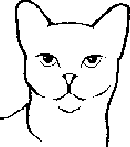
-Introduction-
JUDGES WORKSHOP, 1995----TONKINESE
(BREED STANDARD UPDATED FEBRUARY, 1999)
COMMITTEE MEMBERS:
Sharon Roy - Breed Council Secretary
Joan Bernstein - Presentation of Eye Color
Mary Carsky - Presentation of History/Statistics
Eric Lovgren - Presentation of cats and their colors
Mary Mosshammer - Selection of cats
Cathy Rokaw - Art Work and Booklet Review
Norma Roy - Booklet Review
Bonnie Smith - Compilation of Booklet and Presentation of Type
Kip Smith - Print booklet
A very special Thank you from all of us to Cathy Rokaw for the wonderful drawings she has done for the Booklet. Cathy devoted many hours to the creation of her Tonkinese line drawings and she worked closely with the committee to create pictures that help demonstrate the features of the Tonkinese being presented in the Booklet.
Special recognition must go to Mary Carsky. Mary has spent many days researching the History of the Tonkinese and has created a document whose accuracy is verified by her extensive list of references. Mary's History is the most complete documentation available at this time and contains facts that could have been lost due to the passage of time, if not for her diligence.
A special Thank you to In Touch Software for the use of their equipment and the priceless assistance of their Technician Robert Smith (Smitty) who created the eye color strip and helped us in too many ways to mention
The Committee members wish to thank the Tonkinese Breeders for their invaluable assistance in compiling this book. Without their ideas and contributions it would have been difficult to create a Booklet that endeavors to describe the ideal Tonkinese while avoiding the pitfall of describing the preferences of breeders in a limited geographic area.
The Tonkinese Cat
Judging the Tonkinese is an exercise in perceiving moderation.
The Tonkinese Cat was originally developed by breeding a Siamese with a Burmese. The ideal Tonkinese reflects its origins and is intermediate to the two. CFA Tonkinese breeders and Breed Council members have been breeding Tonkinese to Tonkinese exclusively for the last 15 years with the objective of developing a moderate cat that does not look like either of the parent breeds.
The modern Tonkinese is showing a consistency of type that was
practically impossible to attain in the earlier days of the Breeding program. All Breeds
have different looks that fall within their Standard and the Tonkinese is no exception. We
will endeavor to show you some of the areas where the differences in type fall within the
allowable range and also indicate where we feel they are too extreme. The bold print
indicates excerpts from the official Tonkinese Breed Standard.

HEAD:General Comments
The head is a modified slightly rounded wedge somewhat longer than it is wide, with high gently planed cheekbones.
The Tonkinese head should give a pleasing appearance of balance and moderation when viewed from the front. It should appear neither long and sharply wedge shaped nor round and short. The modified wedge should be slightly rounded without flat planes. We must remember Tonkinese have been bred only to Tonkinese for the last 15 years and they have now developed a look of their own that is best described as moderate. Different parts of the country interpret moderate in slightly different ways and yet the interpretations usually fall well within the Standard.
|
|
|
Profile (8 POINTS)
There is a slight stop at eye level. In profile the tip of the chin lines with the tip of the nose in the same vertical plain. There is a gentle rise from the tip of the nose to the stop. There is a gentle contour with a slight rise from the nose stop to the forehead. There is a slight convex curve to the forehead.
Again the word moderation comes into play. A "slight stop" does not mean an extreme nose break or a ski slope nose. However the stop should always be visible. "A gentle rise from the tip of the nose to the stop" does not mean a hump - it is the normal rise necessary for a cat to breath properly. "A gentle contour with a slight rise from the nose stop to the forehead" does not allow for a deep nose break, "A slight convex curve" above the eyes does not mean the head and skull are round. Remember the head is somewhat longer than it is wide. The word moderation does NOT apply to the chin. The Tonkinese should have a strong chin that lines up with the tip of the nose in the same vertical plane". The chin should neither recede nor protrude when looking at the profile. (see Diagram above).


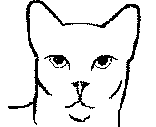
MUZZLE TO SHORT IDEAL TONKINESE MUZZLE TO LONG
Muzzle (6 POINTS)
The muzzle is blunt, as long as it is wide. There is a slight whisker break, gently curved, following the lines of the wedge.
Ideally, the muzzle is blunt, slightly rounded at the corners. There is a slight break in the lines of the wedge in back of the whisker pads.
|
|
|
|
EARS ( 6 points)
Alert, medium in size. Oval tips, broad at the base. Ears set as much on the sides of the head as on the top. Hair on the ears very short and close lying. Leather may show through.
The ears should be medium in size, alert, and should actually appear to be pricked forward, NOT STANDING STRAIGHT UP.. The space between the ears should be 1 to 1 1/2 times the width at the base of the ears.
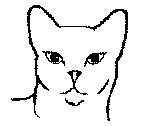 EYES TOO ORIENTAL |
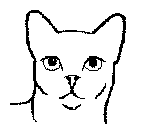 EYES TOO ROUND |
EYES - shape and set (5 points)
Open almond shape. Slanted along the cheekbones toward the outer edge of the ear. Eyes are proportionate in size to the face.
The pupil in a cats eye is always round so we are referring to the aperture of the eye when we describe an "open almond eye". The diagram shows the aperture slanting toward the outer edge of the ear . The word MODERATION is back. "Eyes are proportionate in size to the face." Neither large owl like eyes nor small or squinty eyes are desired.
|
BODY: General Remarks
The ideal Tonkinese is intermediate in type, being neither cobby nor svelte. The Tonkinese should give the overall impression of an alert, active cat with good muscular development. The cat should be surprisingly heavy. While the breed is to be considered medium in size, balance and proportion are of greater importance.
Neither cobby nor svelte. Again moderate comes to mind.
Many of you have caught an airborne Tonk who is exhibiting his ability to
be alert and active with good muscular development. I'll bet you noticed he was
surprisingly heavy too.
The Tonkinese is considered a medium size cat, neither a very small or delicate cat nor an
overly large or raw boned cat are desirable. Allowance should be made for the fact that
the Tonkinese female is frequently smaller than the Tonkinese male. Keep in mind that
balance and proportion are of greater importance than size alone.
Body too long. |
Body Too short.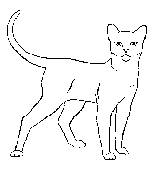 |
TORSO (15 POINTS)
Medium in length, demonstrating well-developed muscular strength without coarseness. The Tonkinese conformation strikes a midpoint between the extremes of long, svelte body types and cobby, compact body types. Balance and proportion are more important than size alone. The abdomen should be taut, well-muscled and firm.
The torso should be medium in length with the rib cage smoothly rounded. The abdomen should be firm and well-muscled exhibiting no loose skin. The cat should have noticeably developed muscles but not appear bulky or coarse. The shoulders and hips should be approximately equal in size. The extremes are long and svelte or short and cobby - the moderate is again desired emphasizing balance, proportion and well-developed musculature.
|
Legs too long. |
|
LEGS AND FEET (5 POINTS)
Fairly slim, proportionate in length and bone to the body. Hind legs slightly longer than front. Paws more oval than round. Trim. Toes: five in front and four behind.
Legs and feet are to be in balance with the rest of the cat. Large boned legs on a trim and graceful female would seem as out of place as thin delicate legs on a large boned male. Better to see leg boning and foot structure that is harmonious with the rest of the cat. The Tonkinese in keeping with the theme of a moderate cat should not appear to be standing on legs too long for its body nor should they appear short and stubby. The hind legs are slightly longer and give the Tonkinese much of its jumping ability. We don't want to overlook the lovely moderately oval paw shape and of course the Tonkinese has the traditional five toes in front and four toes behind.
TAIL (5 POINTS)
Proportionate in length to body. Tapering.
The tail should be in harmony with the rest of the cat. Ideally the tail is medium long, broader at the base and tapering from there to the tip. It should appear neither long and whippy nor short and stubby.
MUSCLETONE (5 POINTS)
The body should have well defined musculature that reflects the fact the cat is acrobatic and active.
COAT (10 POINTS)
Medium short in length, close-lying, fine, soft and silky, with a lustrous sheen.
The coat is the crowning glory of the Tonkinese. It is a single coat that feels like the fabulous mink it is named for and draws ohs and ahs from spectators across the country. Good grooming always brings out the best in any coat and a well groomed Tonkinese is a real treat to handle. The coat should never feel dry or course and should exhibit a lustrous sheen.
EYE COLOR (10 POINTS)
Aqua. A definitive characteristic of the Tonkinese breed, best seen in natural light. Depth, clarity, and brilliance of color preferred.
Tonkinese eye color, in the color-coordinated cats breeders refer to as "mink," is aqua.. Because aqua eyes are "a definitive characteristic of the breed," eye color is valued at 10% of the total point score - 10 points. No matter how good the overall cat, if eye color is not within the aquamarine spectrum, a cat must be evaluated against its competition, or itself, accordingly.
The breed standard specifies disqualification for yellow (or certainly, gold) eyes, as yellow is obvious. Nothing is said regarding blue or green eyes, as it has been assumed that if a cat's eye color is not clearly aqua, the cat would be automatically penalized for blue or green eyes. Unfortunately, Tonkinese eye color is "best seen in natural light," and few show halls offer this advantage. As a result, it is possible that a cat with true blue or green eyes could be placed above a cat with true aqua eyes, in a situation where eye color is the determining factor between otherwise equal competitors. Tonkinese breeders, on the whole, do not want cats with yellow, green, or vividly blue eyes representing the breed.
Showhall lighting is the main culprit. The biggest problem results from the effects of the yellow or pink lights in sports arenas, and the blue mercury or halogen lights used in many expo centers. Under the former types of lighting, aqua eyes are never aqua. They will almost invariably appear to be gray. Yellow or green or yellow-green eyes, however, will seem to be aqua! The greener the eye color, the more blue-green the eyes appear. Blue eyes will be more intensely blue. Under fluorescents, aqua eyes often turn blue. By looking at the eye in profile , it is sometimes possible to see the true color. Fluorescent lighting washes out blue eyes, but usually makes green eyes look light aqua. Yellow eyes usually remain yellow.
Since Siamese are often in the same ring as the Tonkinese, you may wish to compare the eye color of the two breeds while judging the Tonkinese. If the Siamese eye color is not being affected adversely by the showhall lighting, you may be able to determine, by comparing and contrasting eye color, which Tonkinese actually have aqua eyes. However, it is probably pertinent to keep in mind that If the lighting is affecting Tonkinese eye color it can also cause the Siamese eye color to intensify. While the blue of the Tonkinese is usually lighter than the Siamese, Tonkinese blue eyes can equal that of many Siamese. The best way to see eye color in Tonks is still natural light. Another suggestion is to utilize the white judging table to reflect 'white' light into the cat's eyes. Holding the cat up at an angle to catch the table reflection, , excluding the colors in the surrounding decor (red, pink, or yellow table cover), it should be possible to discern eye color accurately.
There are no hard and fast rules, but if showhall lighting is creating a verdigris sheen on the Abys and Somalis, you can safely assume that the Tonkinese with gray eyes actually have the best aqua eye color!
The reason for the change in eye color under different types of lighting is that, like Siamese, the Tonkinese eye color is created by the reflection of light off the protein layer of the eyes. There is some pigmentation in the Tonkinese iris, due to the Burmese influence. According to Roy Robinson (Genetics for Cat Breeders), eye color may also be affected by the brown and dilution genes, which would affect the intensity, if not the actual color, of Tonkinese eyes. Maturity and hormones also seem to have an effect. Intense eye color in kittens may fade away as the kitten matures. Blue, green, even yellow eyes have been known to turn aqua at full sexual maturity. Tonkinese breeder/owners check eye color constantly, especially in cats they are showing. No Tonk exhibitor can rest secure in the knowledge their cat will leave home with aqua eyes and arrive in the show hall with the same eye color. Thus judges cannot assume that a Tonkinese they have handled frequently in the show ring will have the same eye color-- good or bad-- that it had the previous week. Tonk eye color seems to change like lightning. Ambient lighting is probably most responsible, but these other factors must be taken into consideration.
Tonks with poor eye color may be given the benefit of the doubt if the kitten/cat has an aqua ring around the pupil. This is usually indicative that the entire iris will eventually become aqua. However, unless such a cat has a great deal to recommend it, it should not place over a good Tonk with vivid aqua eye color. No allowance is suggested for weaker eye color in platinum mink Tonkinese, or "bluer" eye color in blue mink Tonks. ALL Tonkinese colors can exhibit the "depth, clarity and brilliance of color" the standard requires.
The AOV solid-colored Tonks usually have eye color ranging from yellow through green, while the pointed AOV Tonks have blue eyes. This conclusion is not, however, cast in stone, since while no exceptions have been reported in the latter, their have been numerous reports of solid-color Tonks with aqua eyes, even after borderline-colored cats were proven by the breeding process to be solids. The same is true of honey and fawn solid or pointed AOVs. Honey and fawn minks (also AOVs at this time) show the same range of color, aqua as well as 'discrepancies,' as the other mink and AOV colors.
Webster's Unabridged Dictionary defines "aquamarine" as "a bluish-green color." The word "aqua" is an abbreviation of "aquamarine'. As with gemstones, there is variation within the blue-green spectrum, i.e. a range of acceptable color. (See color strip) However, no matter how 'interpretive' the word "aqua" may be, there is no question that its definition requires the presence of a blend of both blue and green. If these two requisite colors are not present, the resulting color is not aqua.
TONKINESE COLOR: General Comments:
Tonkinese are recognized by CFA in four different coat colors, Natural, Champagne, Platinum and Blue.
Each of the four colors come in 3 different patterns: Mink, Pointed, and Self . The mink pattern is the only one approved for Championship competition but it is important to be familiar with the AOV patterns and to be able to identify them.
BODY COLOR (15 points)
The mature specimen should be a rich, even, unmarked color, shading almost imperceptibly to a slightly lighter hue on the underparts. Allowance to be made for lighter body color in young cats. With the dilute colors in particular, development of full body color may take up to 16 months. Cats do darken with age, but there must be a distinct contrast between body color and points.
Rich, even and unmarked are pretty self explanatory , they indicate a coat that does not have blotches of color or any type of pattern. Although the Standard makes allowance for "lighter body color in young cats" there is no indication that a light coat in an adult should be penalized or rewarded any more than a darker coat. The important thing to look for is "contrast between body color and points". Neither a cat so dark the points aren't easily seen nor a cat that is very light with points to pale to be seen should be considered as desirable. The blue mink is an excellent color to help sharpen your skills when checking point and coat color. The blue mink has a tendency at times to have a coat so dark it does not show the contrast the standard requires. However there are breeding programs producing blue mink Tonkinese with a coat color that is light enough to show the contrast and thereby meet the standard. The Natural Mink also has this problem at times, especially when the natural darkening caused by age sets in. We should keep in mind the fact that the Standard describes the Perfect Tonkinese and we are constantly striving to meet it.
POINT COLOR (10 POINTS)
Mask, ears, feet, and tail all densely marked, but merging gently into body color. Except in kittens, mask and ears should be connected by tracings.
The points should be easily identified as being a deeper, and denser shade of the coat color . The points should all have the same density of color, therefore a dark tail and dark ears on a cat with pale feet would be less desirable. Again allowance should be made for kittens whose point color often comes in slowly. The points should gradually soften in color as they merge gently with the body color. Barring can be difficult to discern under some show hall lighting but a helpful hint would be to hold the cat sideways, with the ring lighting behind you, coat clarity becomes very evident. Rings or barring in the tail are an indication there is usually barring elsewhere on the cat.
PENALIZE:
Extreme ranginess or cobbiness. Definite nose break. Round eyes.
DISQUALIFY:
Yellow eyes. White locket or button. Crossed eyes. Tail faults.
TONKINESE COLORS
APPROVED FOR CHAMPIONSHIP
NATURAL MINK:
BODY: medium brown. Ruddy highlights acceptable.
POINTS:Dark Brown
NOSE LEATHER: Dark Brown ( corresponding to the intensity of the point color)
PAW PADS: medium to dark brown (may have a rosy undertone)
CHAMPAGNE MINK:
BODY: buff-cream to beige. Reddish highlights acceptable. Ranging from Cream to
beige
POINTS:Medium brown.
NOSE LEATHER:cinnamon-brown (corresponding to the intensity of the point color).
PAW PADS: cinnamon-pink to cinnamon-brown.
BLUE MINK:
BODY:soft, blue-gray with warm overtones. ranging from light to medium blue>
POINTS:slate blue, distinctly darker than the body color.
NOSE LEATHER: blue-gray (corresponding to the intensity of the point color).
PAW PADS:blue-gray (may have a rosy undertone).
PLATINUM MINK;
BODY: pale, silvery gray with warm overtones. Not white or cream. <pale
lavender>
POINTS: frosty gray, distinctly darker than the body color.
NOSE LEATHER:lavender-pink to lavender-gray.
PAW PADS: lavender-pink
TONKINESE
AOV COLOR STANDARDS
GENERAL DESCRIPTION -SOLID COLORS (AOV): Body color in solid AOVs may
be a slightly lighter shade of the point color, with very little contrast with points.
There will be more contrast between points and body color for the Champagne and Platinum
solid than for the Natural and Blue solids.
EYE COLOR: green to gold
NATURAL SOLID (AOV):
BODY:Sable brown. POINTS: dark brown
NOSE LEATHER: Dark brown (Corresponding to the intensity of the point color).
PAW PADS: Medium to dark brown (may have a rosy undertone).
CHAMPAGNE SOLID: (AOV):
BODY: golden tan to light coffee brown. POINTS: medium brown.
NOSE LEATHER: cinnamon brown (corresponding to the intensity of the point color).
PAW PADS: cinnamon-pink to cinnamon-brown.
BLUE SOLID (AOV):
BODY: slate blue with warm overtones. POINTS: slate blue.
NOSE LEATHER: blue-gray (corresponding to the intensity of the point color).
PAW PADS: blue-gray (may have rosy undertone).
PLATINUM SOLID (AOV)
BODY: dove gray. POINTS: frosty gray.
NOSE LEATHER: lavender-pink to lavender-gray.
PAW PADS: lavender-pink.
GENERAL DESCRIPTION - POINTED COLORS (AOV): Body color in pointed AOVs
should be off-white, any shading relative to the point color; overall body color should be
in marked contrast to the points.
EYE COLOR: Blue.
NATURAL POINT (AOV):
BODY: fawn to cream. POINTS: dark brown.(corresponding to the intensity of
the point color).
PAW PADS: medium to dark brown (may have a rosy undertone).
CHAMPAGNE POINT (AOV)
BODY:Ivory with buff-tan shading. POINTS: medium brown.
NOSE LEATHER: cinnamon-brown (corresponding to the intensity of the point color).
PAW PADS: cinnamon-pink to cinnamon-brown.
BLUE POINT (AOV):
BODY: Off- white with warm gray shading. POINTS:slate blue.
NOSE LEATHER: blue gray (corresponding to the intensity of the point color).
PAW PADS: blue gray (may have a rosy undertone).
PLATINUM POINT (AOV):
BODY:pearly white. POINTS: frosty-gray.
NOSE LEATHER:lavender-pink to lavender-gray (corresponding to the intensity of the
point color).
PAW PADS: lavender-pink.
Copyright © 1995 Sharon Roy